Table of Contents
Drone and anti-drone technologies will continue to evolve and co-exist. The next generation of unmanned aerial vehicles (UAVs) will be lighter, smaller, more complex, and be able to multi-task. Hence the necessity to figure out new, more effective ways of shooting these platforms down.
The use of drones or unmanned aerial vehicles (UAVs), both for military and civilian purposes, has been increasing. At the same time, counter-drone systems have also been developing to address their rising threat. The drones are now available from nano insect-size at one end to a large size comparable to a medium-sized passenger jet aircraft on the other end.
The availability of advanced navigation and satellite communication technologies has revolutionised the use of drones, making them more versatile. They can now endure missions for 30 to 40 hours, far beyond the capabilities of human crew. With in-flight refuelling and ultra-efficient solar power, the drones can provide an even greater range of operation.
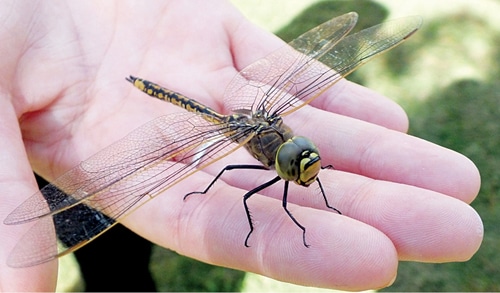
Hostile drones pose threat to military and strategic installations and public security. One way to engage an enemy with minimum casualties is using drones that do not carry human operators, use aerodynamic forces for lift, fly autonomously or are piloted remotely, are either expendable or recoverable, and can carry both lethal and non-lethal payloads.
Drones are becoming the preferred means for intelligence gathering, surveillance, reconnaissance, electronic warfare, strike missions, air combat, and search and rescue missions due to their capability to loiter, search, identify, and strike targets while minimizing collateral damage. Their civil applications include policing, firefighting, inspection of power lines and pipelines, delivering packages, etc.
As drones are becoming increasingly versatile, stealthy, and convenient airborne weapons, there is need for hostile drones to be detected quickly, identified, localised, and neutralised. Counter-drone systems, also called counter-unmanned aerial systems (C-UAS), are used to detect and neutralise the hostile unmanned aerial systems while in flight to protect areas such as critical infrastructure, airports, large public spaces, and military installations.
The Evolution of Drones
Drones were initially used for military applications as the defence forces were quick to recognise their benefit for wartime strategies and tactical usage. Later, the use expanded to commercial, scientific, agricultural, research, and other applications.
Drones were initially developed as balloons and aerial targets for training, target practice, bomb detection, and surveillance. By the early 1900s, the US military was using them as practice aerial targets.
In 1915, Nikola Tesla suggested their use as unmanned aerial combat vehicles and a self-propelled drone was used as an aerial target in 1916. During World War II both Allied and German forces used drones as targets to train aircraft gunners and aid-in missions.
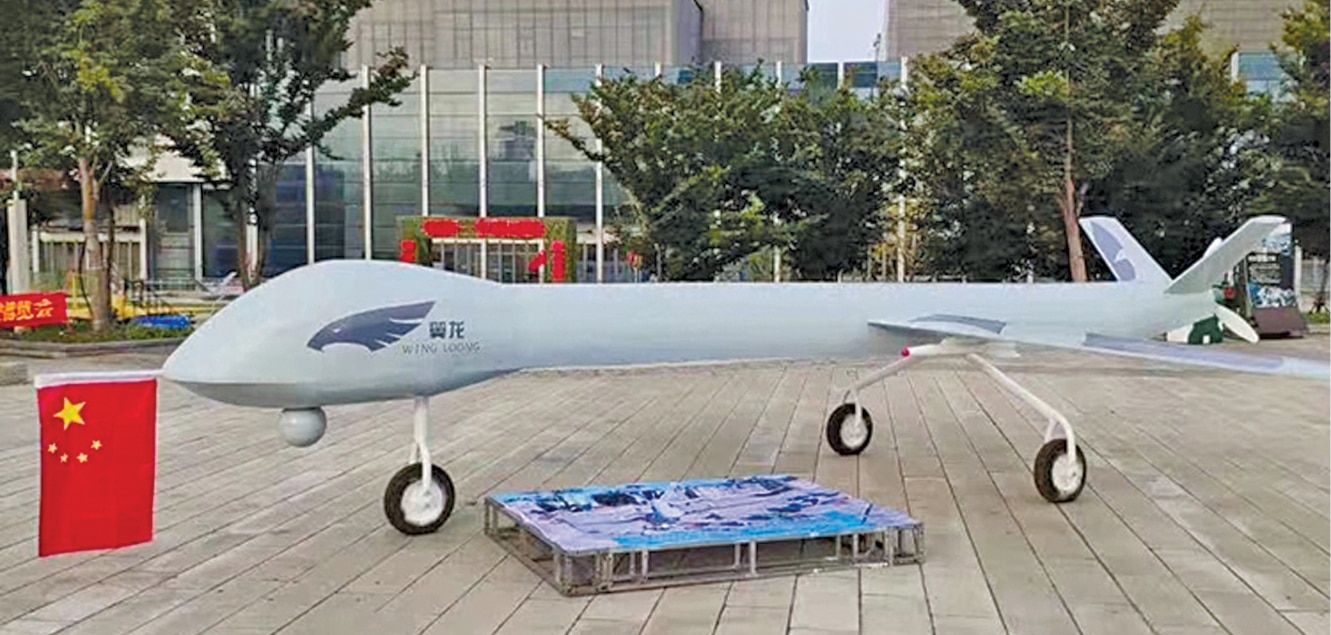
However, not much development took place until the Vietnam War. From the early years of the Vietnam War, the US Air Force started using the unmanned combat aircrafts to cut down on pilot casualties. The development got speeded up for decoy and surveillance applications when an American spy plane was shot down by the Soviet Union in 1960.
During the 1990s, the US began developing more advanced and cost-efficient drones. Today, they have become an essential part of military missions and operations and are in high demand by nearly every military and law-enforcement agency.
Drones’ use for non-military purposes started in 2006, when the Federal Aviation Administration of the USA issued the first commercial drone permit. Government agencies quickly began using drones for disaster relief and border surveillance while corporates began using them for commercial applications like pipeline inspection, crop evaluation, and security.
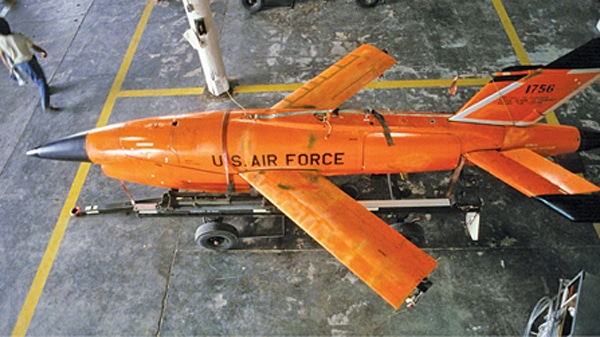
In 2013, Amazon started using drones for delivering orders. In 2018, companies around the world began developing drones for taxi services, photography, and indoor applications.
Drones have a bright future with their increasing use by the industry and applications into many more fields. Negative forces like terrorists and drug cartels are at work too, and are increasingly using drones for smuggling contrabands, dropping arms, explosives and IEDs, and terroristic raids. It is estimated that currently over three-dozen countries and multiple terrorist groups and non-state actors possess weaponised drones in their arsenal.
Counter-drone systems identify and neutralise the unknown drones by taking into account their flight path, physical properties such as size and kinetic energy, the number of swarming drones, and the likely damage which could be caused. Counter-drone systems are preferably portable and have the capability of defending the facilities like military establishments and sites, airports, sports stadia, and outdoor/indoor convention sites by quickly detecting multiple drones at sufficient distances.
Counter-drone systems have two parts—monitoring equipment and countermeasure equipment.
Drone Monitoring Equipment
Drone monitoring equipment detect the approaching drones, classify them from other types of objects—like planes, birds, trains, and automobiles, identify if they are hostile or illegal, locate and track their flight path, determine the hazard level, and provide alert about their presence. Drone monitoring exploits various features of flying drones, such as the heat emitted, sound generated, and radio frequency (RF) spectrum used.
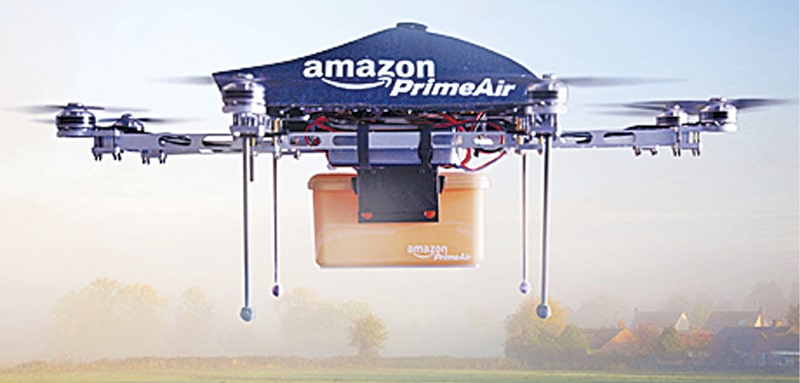
Drone monitoring equipment can be passive—simply looking or listening, or active—sending a signal out and analysing what comes back. Drones have low radar cross-section (RCS), slow speed, and usually small size, making the task of detection difficult and thereafter identification and localisation even more difficult. Various technologies available include RF-analysers, radars, acoustic sensors, optical/infrared sensors, thermal detectors, and hybrid detectors.
Radio Frequency (RF) Analysers
Drone-detection RF monitoring system operators communicate with drones through RF signals, which include sensor outputs, location data, flight commands, and their media access control (MAC) address—a unique identification number. RF analysers intercept these signals to identify the make, model, and controller of the approaching drones. Some high-end analysers have the capability to triangulate the drones and their controllers using multiple receiver units spread far apart.
RF analysers provide long range, are low-cost, can detect and identify multiple drones and their controllers, and are passive. However, they are not capable of detecting drones that do not exchange RF signals, use different frequency bands, have autonomous navigation and/or unknown control protocols. RF analysers are less effective in crowded RF areas.
Radar
Though radar is a useful tool for detection of drones, there are limitations like low altitude, velocity of flying, and their small RCS, making it difficult to distinguish them from the noise and clutter present. Sometimes, multi-static radars are used to monitor, track, and analyse the energy back-scattered from rotating parts like propellers and rotors for drone detection.
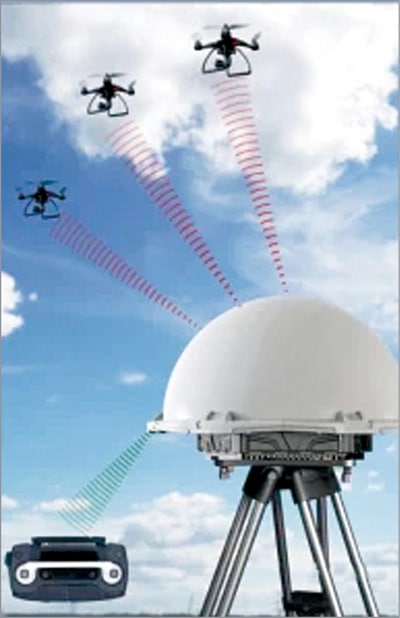
Radars are classified as 2D and 3D by the type of the phase array antenna used. 2D radars use passive electronically scanned array antennas (PESAs) and provide relatively large detection range. However, 3D radars use active electronically scanned array antennas (AESAs), have relatively short detection range, can self-correct errors, and support wideband detection. 3D radars are preferred as they can estimate the altitude of target objects. Radar based detection systems offer longer range and constant observability compared with RF scanners, but have regulatory limitations for use.
At times radars find it difficult to distinguish between drones and the obstacles when the drones hover in one position or fly at low speed and are mostly employed in conjunction with other technologies (camera, RF scanner, etc). Radars emit high-power RF signals, therefore other facilities using radars, such as airports, may face RF interference issues. Partial spectral overlap between radar and radio waves can cause signal interference and poor performance of both radar and the radio networks.
Acoustic Sensors (microphones)
During flight the sound generated by the rotors can be utilised in detection, classification, and localisation of drones. Acoustic sensors, usually microphones or microphone arrays, are used to detect the sound generated and calculate the direction of the flight using algorithms such as multiple signal classification (MUSIC).
Acoustic sensors can detect drones within the near-field and even those that are operating autonomously and not emitting RF radiations. Some systems use tetrahedron acoustic arrays (four microphones in a tetrahedral array located about one metre above the ground) for detection, recognition, and to find out the direction of arrival.
Acoustic sensors can detect drones in the ground clutter where other technologies can struggle, are a great gap-filler, provide high mobility, are quickly deployable, and are completely passive. However, they do not work very well in noisy environment, have very short range (max. 300-500m), and are mostly used along with other detection techniques.
Optical/Infrared Sensors
These sensors are essentially daylight or infrared (IR) scanners, which detect objects based on their appearance and motion features across consecutive frames. IR scanners are useful in conditions of low visibility.
However, there are disadvantages, such as low spatial resolution, low image contrast due to diffused edges, presence of noise and pulse disturbances, high false-alarm rates, relatively poor performance in dark, fog, etc, and are not preferred as stand-alone systems. Visuals of the drones and their payload provide useful forensic evidence.
Thermal Detectors
The motors, batteries, and other on-board equipment of drones radiate significant amount of heat that imparts thermal signatures, which can be recognised by thermal sensors. Thermal detection has advantages in terms of weather resilience, identification availability, and lower costs, but the range is limited.
Hybrid Detectors
Using a single method for detection may cause blind spots, making successful neutralisation difficult. Hybrid detection systems with sensor fusion technology and joint control system provide greater accuracy and installation flexibility.
Radar and optical or thermal cameras provide good balance as radars scan the target area, while vision systems control the external and internal parameters, enabling accurate investigation using image zoom, tilt, and focus. While the RF scanners can gather information like type, control commands, etc, they are unable to provide the location, for which they are combined with acoustic or optical/thermal sensors.
Countermeasure Equipment
Countermeasure equipment physically destroys the drones by neutralising them or overpowering their movement, or even taking control of them. They are classified as destructive and non-destructive. Non-destructive countermeasures prevent secondary crises-landing or crashing.
Drone jamming
Drone jamming involves paralysing radio communication between the target drone and its controller to make it uncontrollable by using powerful interfering RF signals. The options include jamming the drone-controller link or jamming the GPS link so that it loses control of ‘auto-home’ facility.
The jamming systems can be directional or omnidirectional. In directional jamming, the power is confined spatially, decreasing the possibility of interference with the co-located RF devices/equipment. Stationary jammers are installed at a fixed location, whereas mobile jammers operate from portable devices that are handheld or vehicle-mounted.
RF jammers are of medium cost and provide non-destructive neutralisation, have short range, may affect and/or jam other radio communications, and can result in unpredictable drone behaviour, such as unintentionally sending the drone to its target. They can cause significant unintended impacts, such as interference with the TV broadcasts, telecommunications, or even the air-traffic control systems.
GPS spoofers
Controllers use GPS satellites to navigate the drones. Fake GPS signals are used to spoof the communication with the satellites, preventing the drone from moving as intended by the controller. The drone is ‘spoofed’ into thinking it’s somewhere else and loses control of auto-home facility and can be hijacked and diverted to a desired zone. Drone hijacking is an ideal approach, facilitating follow-up investigation.
GPS spoofers are of medium cost, provide non-destructive neutralisation, have short range, and may affect and/or jam other radio communications in the area.
Geofencing
Geofence is a dynamically generated virtual perimeter for a real-world geographic area, which could be in a radius around a point location, or a predefined set of boundaries. In geofence neutralisation the target drones are prevented from approaching the pre-defined point or entering the defined boundaries, thus blocking them from trespassing.
Geofencing could be dynamic or static
In dynamic geofencing the information regarding restricted area is continuously propagated. Static geofencing uses a flight permission information repository, which when accessed by the intruding drone denies it access beyond the intended point.
Most commercial drones use internal auto-landing modules for safety. Geofencing is unable to disable these automatic landing systems.
Killer drones
Killer drones are employed to track and destroy the invading drones by physically striking them down. This technique requires reactive and real-time decision making, accurate target flying path estimation, and outstanding physical durability and mobility. Swarming killer drones with distributed intelligence and precise tracking systems are promising solution for drone fleet multi-faceted attacks.
High-power microwave pulses
High-power microwave (HPM) devices generate electromagnetic pulses (EMPs) capable of disrupting electronic devices. The EMPs interfere with the radio links and disrupt or even destroy the electronic circuitry by inducing damaging voltages and currents. As a result, the targeted drone falls uncontrolled instantly.
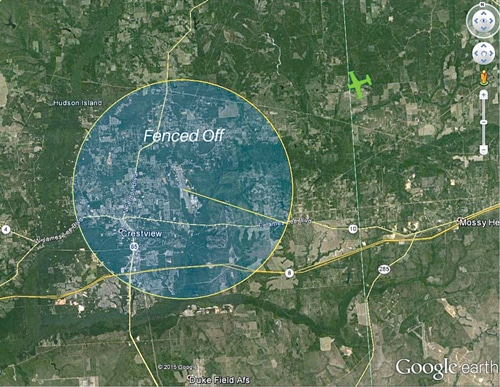
HPM devices use an antenna to focus the EMPs in the required direction to reduce the potential collateral damage. Within the range, EMPs provide effective non-destructive neutralisation, but have high cost, and create risk of unintentionally disrupting communications or destroying other electronic devices in the area.
High-Energy Lasers
High-energy lasers use high-powered extremely focused laser beams to destroy the structure and/or the electronics of the targeted drone. They are high-cost, carry risk of collateral damage and are bulky in size.
Nets and net guns
Firing a net at a targeted drone, or bringing a net into contact with it immobilises it by prohibiting the rotor blades from moving. Mainly, they are of three types:
- Net cannons fired from the ground. These could be hand-held, shoulder-launched, or turret-mounted. They have limited effective range, anywhere from 20m to 300m, and can be used with or without a parachute for controlled descent of the captured drone.
- Net cannons fired from another drone. These overcome the limited range of those fired from the ground and are normally used with a parachute for controlled descent of the captured drone.
- Hanging net deployed from a ‘net drone.’ The targeted drone is captured by manoeuvring a net-carrying drone towards it. The ‘net drone’ is normally capable of carrying the captured drone to a safe zone. However, if it is too heavy, the captured drone is released with a parachute for controlled descent, or it is allowed to crash. Physically capturing the drone facilitates a forensic examination and prosecution.
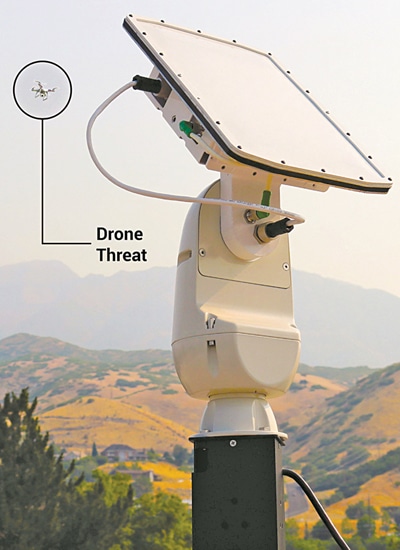
The ground-launched net cannons are semi-automatic with high accuracy and have a short range. The drone-deployed nets provide long range and low risk of collateral damage. Drone-deployed nets are imprecise and have long reload time.
Birds of Prey
This technique takes advantage of the natural hunting instinct of the eagles, used by man for hunting for thousands of years. It is possible to train eagles to capture drones. This low-tech solution requires a lot of manpower and time for training and maintenance of these birds of prey (at least one year per bird).
Interception of the drone by these birds of prey can be quick and accurate with low risk of collateral damage. They are difficult to scale due to limited number of birds available and could be an air hazard at airports.
Integrated counter-drone systems
Integrated counter-drone systems are a match-and-mix of the technologies, depending on the specific use. In the integrated system the data from different sensors is collected, processed, and displayed in a user-friendly way. Software provides effective command, control, and communication (C3). The systems are mostly scalable, sensor-agnostic, and user-friendly. Some examples of the existing systems are:
Guardion Modular Counter–UAS System
It provides a protective shield against the threat of unauthorised drones to both civil and military installations.The system is used by the German Armed Forces and airports to provide countermeasures against threats, such as hostile/illegal intrusion, smuggling, and terrorist attacks. The features include early warning, automatic detection and classification, powerful core intelligence and C3, and flexible customised deployment capability.
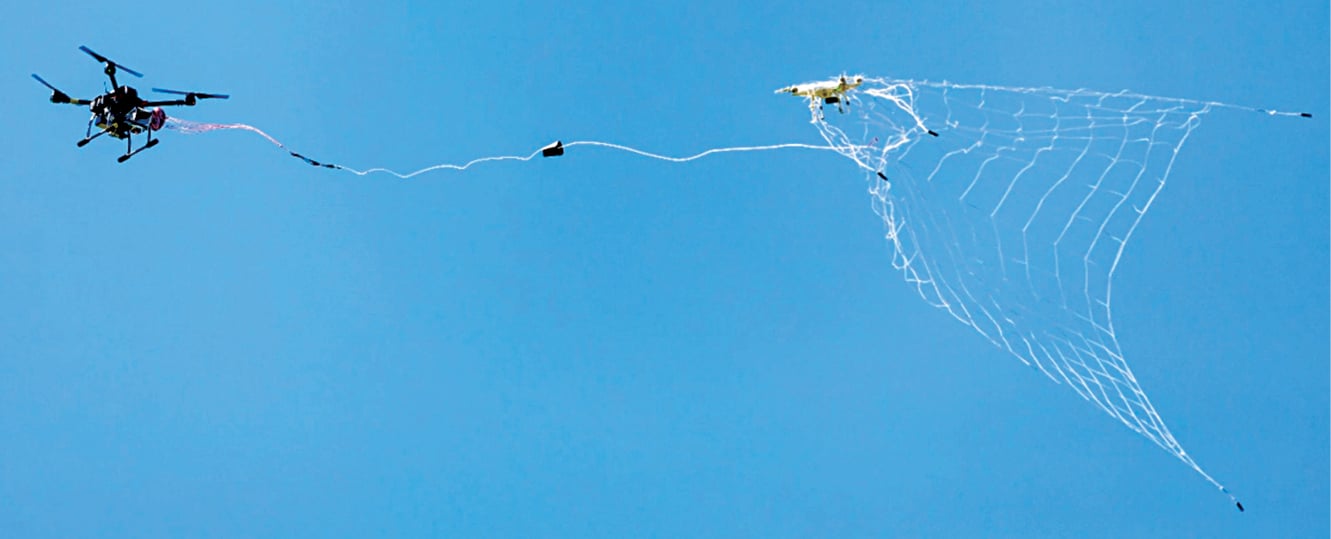
DRDO-Developed Counter-Drone System
A counter-drone system has been developed by the DRDO to enable the Indian Armed Forces swiftly detect, intercept, and destroy small drones using both the soft kill and hard kill options. Soft kill refers to jamming the hostile drone, while hard kill neutralises the target drone.
The system uses radar that offers 360-degree coverage with detection of micro drones 4km away, electro-optical/infrared (EO/IR) sensors for detection of micro drones up to 2km, and a radio frequency (RF) detector to detect RF communication up to 3km. After detection it hands over the track for soft kill/hard kill.
The RF-jammer used for neutralisation is capable of jamming the signals of the hostile drone from a distance of 3km using the Global Navigation Satellite System (GNSS). The laser based hard kill system used can neutralise micro drones 150 metres to one kilometre away. The system is integrated through a command post.
Anti-drone innovative systems
Some innovative, low-cost and simple to use solutions are available for disabling the drones. SMASH 2000, an optical sight used in small arms for precision aiming, has been modified. The advanced version, SMASH 2000 Plus, uses built-in algorithms to provide capability to track and hit even very small drones flying at high speed at range up to 120 metres, both during day and nighttime.
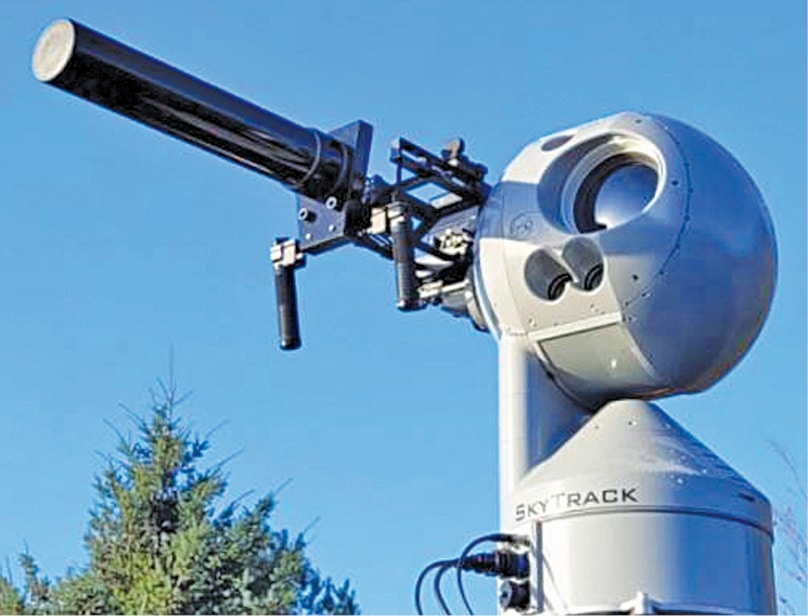
DroneKiller is another standalone handheld anti-drone device available from IXI EW. The device using software-defined radio technology, operating on seven frequency bands, can neutralise drones up to a range of 1000 metres and be in active mode for up to two hours (eight hours in standby), weighs 3.4kg and is comfortable to carry.
Conclusion
Drones are here to stay and we have to face them. They pose ever-increasing, multifaceted threat to civil and military infrastructure, assets and people and are being increasingly used for nefarious activities like terror and illegal surveillance, as improvised explosive devices (IEDs), and to transport arms, drugs, and other contraband. Drones have been adopted by corporates and civil bodies for urban mobility, delivery services, crisis management, disaster recovery, and emergency supply, to name a few.
From the military point of view, we are now entering the ‘second drone age’ in which countries are increasingly employing drones for covert operations and tactical use. In bigger role, the counter-drone systems work in tandem with reconnaissance, intelligence, surveillance and target acquisition (RISTA), and electronic warfare systems to tackle the threat of stand-alone drones as well as swarms.
The advent of the Internet of Things (IoT) and 5G technologies is opening up new possibilities to operate drones. The 4th generation GPS systems are becoming increasingly more interference-proof. Long Term Evolution (LTE)—a high-performance interface for cellular mobile communication systems to increase the capacity and speed of networks—is enabling drones to operate at theoretically unlimited ranges without RF links.

With a drone flying at 20 metres per second, taking less than a minute to cover one kilometre, an operator will have only a few seconds to react from the time of detection and determining the drone’s intention. In such a dynamic situation, the state-of-the-art counter systems need to be developed and continuously updated.
The good news is that the counter-drone technologies are becoming smarter, more sophisticated, and are using innovative approaches, such as machine learning, sensor fusion, cognitive and holographic radars, and augmented reality. Nevertheless, experts agree that no single ‘silver bullet’ will ever exist to cope with the drone threat.
Finally, innovative and out-of-the-box thinking is essential to face the problems modern warfare brings, such as uncontrolled and fast-developing technologies, unestablished legal frameworks, and complex ethical questions.
Dr Deepak Halan is currently Associate Professor with Jaipuria Institute of Management, NOIDA






